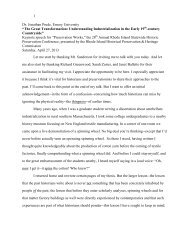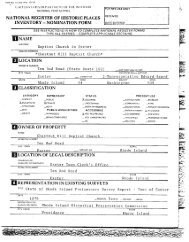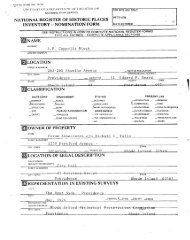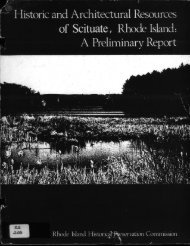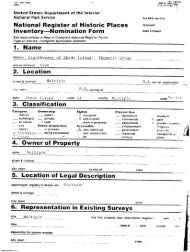National Park Service - Rhode Island Historical Preservation ...
National Park Service - Rhode Island Historical Preservation ...
National Park Service - Rhode Island Historical Preservation ...
You also want an ePaper? Increase the reach of your titles
YUMPU automatically turns print PDFs into web optimized ePapers that Google loves.
0MB Nt 1024-0018<br />
NPS Form 10-900-i - En,- 10-31-U<br />
3-82<br />
United States Department of the Interior<br />
<strong>National</strong> <strong>Park</strong> <strong>Service</strong> - -<br />
<strong>National</strong> Register of Historic Places -<br />
Inventory-Nomination Form -<br />
Continuation sheet 51 -<br />
- Item number 8<br />
Page 7<br />
to not look like a company town. It was part of the Hazards’<br />
social scheme to improve the lot of their workers by creating an -<br />
environment in which social hierarchy and corporate domination<br />
could not be read in the very pattern of the streets and dull<br />
uniformity of its housing.<br />
In the field of engineering, Peace Dale’s bridges and water<br />
power system are significant artifacts. The group of five extant<br />
- stone-arch bridges in the village #35, 78, 92, 93, and 162<br />
dating -to the 1880s, all designed by Rowland Hazard II and built<br />
by local masons, is unparalleled in the state in terms of number,<br />
range of size, variety of form, and quality of construction. The<br />
pond, dam, penstock house, and mill race make up a typical -<br />
moderate-size nineteenth-century hydropower system #16,<br />
noteworthy as a well preserved and very beautiful example of this<br />
once-common class of engineering work. -<br />
Peace Dale holds a place of distinction in the annals of<br />
American industry. Here was a very early and possibly the<br />
first integrated textile manufacturing enterprise in the United<br />
States. Moreover, the Peace Dale Manufacturing Company was<br />
widely known as a producer of high-quality woolen goods and is<br />
credited as an early worsted mill. Equal if not greater import<br />
derives from the Hazards’ progressive labor policies -- provision<br />
of a safe and attractive workplace, "deinstitutionalized" housing<br />
and community setting, opportunities for home ownership,<br />
education, recreational facilities, and profit sharing. At an<br />
entirely different level, one also values, in the context of<br />
industrial history, the Hazards’ decision to preserve, as a<br />
monument to the company’s heritages the stair tower, belfry and<br />
end gable of the 1847 stone factory #37B when the mill complex<br />
- - was greatly altered and enlarged.<br />
Two examples of the work of landscape architect Charles -<br />
Eliot merit attention in this account of Peace Dale’s -<br />
significance: the "Water Way" he created along mill race and<br />
pond #16, and his design of the grounds of the Hazard Memorial<br />
#38. -<br />
Lastly, in the area of "social/humanitarian" significance,<br />
the history of social engineering, utopianism, and benevolent<br />
paternalism which so directly shaped Peace Dale’s institutions,<br />
layout, and buildings, has great importance. The Hazard family<br />
made a very serious and sustained effort to create an ideal<br />
environment for their workers. They did this through provision<br />
of benefits like pensions and profit-sharing which were decades







